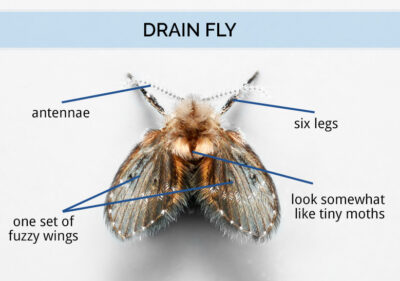Fruit flies can quickly turn your kitchen into a breeding ground for these persistent pests. With their rapid reproduction cycle and attraction to ripening produce, a small problem can become a major infestation in just days. Fortunately, effective fruit fly traps offer a simple, proven solution to eliminate fruit flies and reclaim your space.
Quick Picks: Best Fruit Fly Traps
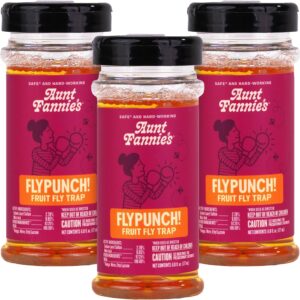
Editor’s Choice
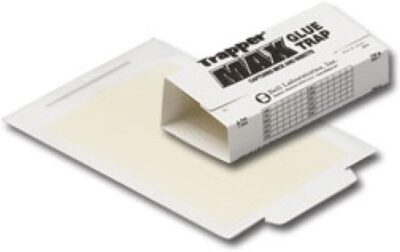
Best Value
How Fruit Fly Traps Work
Fruit flies possess an incredibly sensitive sense of smell that can detect fermenting organic matter from considerable distances. This biological trait makes them vulnerable to well-designed traps that exploit their natural behavior patterns.
Attraction Phase
Traps use specific scents like vinegar, wine, or overripe fruit to lure flies from their hiding spots.
Capture Mechanism
Once attracted, flies enter through small openings or stick to adhesive surfaces, preventing escape.
Elimination
Trapped flies either drown in liquid solutions or become immobilized on sticky surfaces.
7 Most Effective Fruit Fly Trap Methods
Each trap type offers unique advantages depending on your specific situation and available materials. Here are the most proven methods for eliminating fruit flies:
1. Apple Cider Vinegar Trap
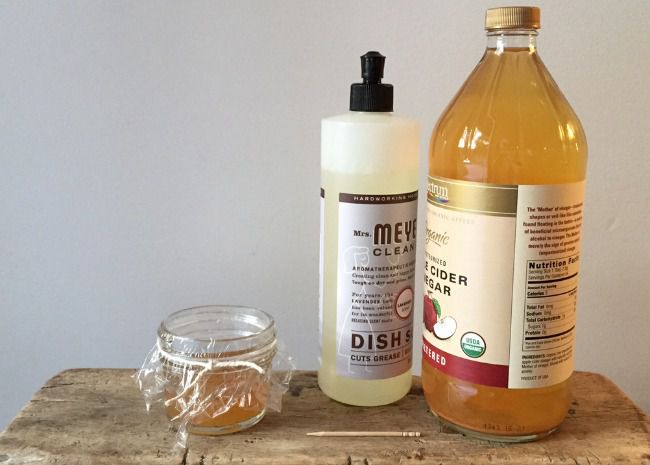
The apple cider vinegar trap remains the gold standard for DIY fruit fly control due to its powerful fermented scent and easy assembly.
Materials Needed:
- Wide-mouth jar or bowl
- Apple cider vinegar (1/2 cup)
- Liquid dish soap (3-4 drops)
- Plastic wrap
- Rubber band or tape
- Toothpick
Step-by-Step Instructions:
- Fill your container halfway with apple cider vinegar
- Add 3-4 drops of dish soap to break surface tension
- Stretch plastic wrap tightly over the opening
- Secure with rubber band or tape
- Poke 6-8 small holes using a toothpick
- Place in areas with high fruit fly activity
2. Fresh Fruit Bait Trap
Using actual fruit leverages the most natural attractant available, making this method highly effective for stubborn infestations.
Best Fruit Choices:
- Overripe bananas (most effective)
- Soft peaches or nectarines
- Bruised apples
- Very ripe tomatoes
3. Red Wine Trap
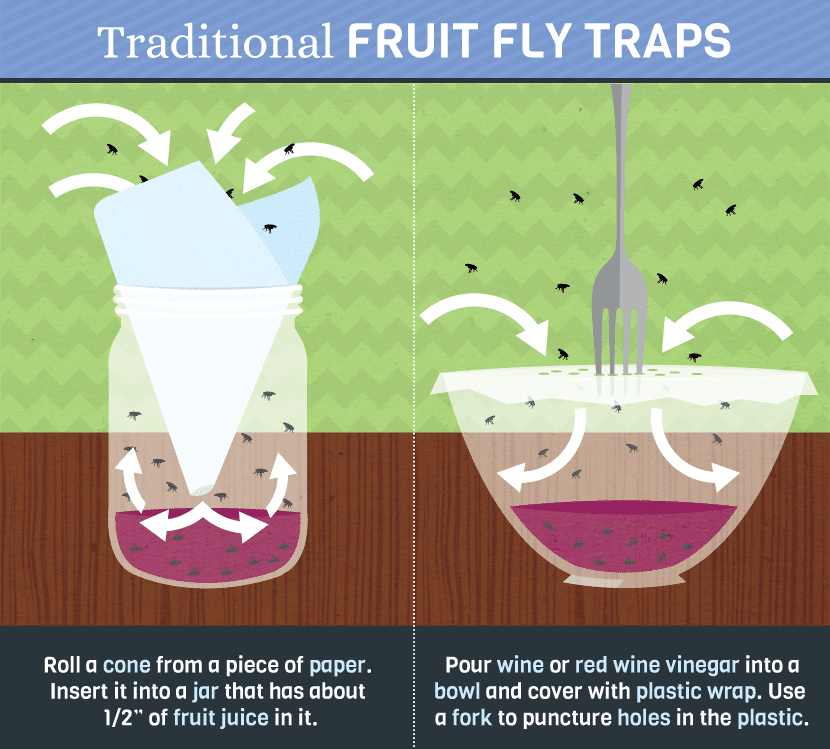
The fermentation compounds in red wine create an irresistible lure for fruit flies, making this an elegant solution for wine enthusiasts.
Setup Instructions:
- Pour 1/3 cup of red wine into a jar
- Cover tightly with plastic wrap
- Create 4-6 entry holes with a toothpick
- Position near problem areas
Wine Selection Tips
- Sweeter wines work better than dry varieties
- Slightly aged wine is more effective than fresh
- Even cheap wine works perfectly for traps
4. Sugar Water and Dish Soap Trap
This simple combination provides an effective alternative when vinegar or wine isn’t available.
Recipe:
- 1/4 cup warm water
- 2 tablespoons white sugar
- 3-4 drops dish soap
Stir until sugar completely dissolves, then set up like other liquid traps with plastic wrap and entry holes.
5. Funnel Trap Design
The funnel trap offers superior capture rates by creating a one-way entry system that prevents escape.
Construction Steps:
- Add your chosen attractant to a jar
- Roll paper into a cone with 1/4-inch opening at the tip
- Insert funnel so tip doesn’t touch the liquid
- Tape funnel edges to jar rim
6. Commercial Fruit Fly Traps
Aunt Fannie's FlyPunch Fruit Fly Trap
Editor's ChoiceHow Does It Work
How to Use
- Remove the protective seal and flip open the top
- Place trap near areas with fruit fly activity
- Position away from food preparation areas but close to problem zones
- Replace after 30 days or when trap becomes full
- Ready to use with no mixing or preparation required
- Non-toxic formula safe around children and pets
- Effective for up to 30 days per trap
- Compact design fits in tight spaces
- No messy cleanup required
- More expensive than DIY alternatives
- Single-use design creates more waste
- May not work as quickly as some homemade traps
7. Sticky Traps
TrapMax Fruit Fly Sticky Traps
Best ValueHow Does It Work
How to Use
- Open the trap and add bait like fruit pieces or vinegar
- Attach a yellow sticker to the provided stick
- Insert the stick into the trap and close the lid
- Hang or place trap in areas with fruit fly activity
- Replace sticker when full or after 2 weeks
- Reusable design provides long-term value
- Waterproof and UV-resistant for outdoor use
- Customizable with your preferred bait
- Includes 12 replacement stickers
- Effective for multiple pest types
- Requires regular sticker replacement
- Less discreet than liquid traps
- May catch beneficial insects if used outdoors
Trap Placement and Optimization
Strategic placement significantly impacts trap effectiveness. Understanding fruit fly behavior helps you position traps for maximum capture rates.
Prime Locations
- Near fruit bowls and produce storage
- Close to garbage disposals
- Around compost containers
- Near houseplant soil
Environmental Factors
- Room temperature areas (68-72°F optimal)
- Avoid direct sunlight
- Areas with slight air circulation
- Away from strong air currents
Distance Guidelines
- 3-6 feet from breeding sources
- Multiple traps for large areas
- Elevated positions when possible
- Away from food preparation zones
Prevention Strategies
While traps eliminate existing populations, prevention stops new infestations before they start.
Troubleshooting Common Issues
Trap Not Attracting Flies
- Check bait freshness – replace every 3-4 days
- Verify hole size – should be large enough for entry but small enough to prevent easy escape
- Try different attractants – some fly populations prefer specific scents
- Ensure traps are positioned in active fly zones
Flies Escaping from Traps
- Add more dish soap to reduce surface tension
- Make entry holes smaller
- Check that plastic wrap is tightly sealed
- Position traps away from air currents
Slow Results
- Increase the number of traps
- Address breeding sources first
- Clean areas thoroughly before setting traps
- Be patient – complete elimination takes 1-2 weeks
Natural vs. Chemical Solutions
| Method Type | Effectiveness | Safety | Cost | Best For |
|---|---|---|---|---|
| DIY Vinegar Traps | High | Completely Safe | Very Low | Most situations |
| Commercial Natural Traps | High | Safe | Medium | Convenience seekers |
| Sticky Traps | Medium-High | Safe | Medium | Long-term monitoring |
| Chemical Sprays | Fast but temporary | Requires caution | Medium | Severe infestations only |
Health and Safety Considerations
While fruit flies are primarily considered nuisance pests, recent scientific research has revealed they can pose food safety risks beyond simple annoyance.
Studies published in Applied and Environmental Microbiology found that fruit flies can accumulate approximately 2,900 bacterial colony-forming units per fly within 2 hours of exposure to contaminated food sources, and these bacteria levels remain stable for at least 48 hours .
This research underscores why prompt fruit fly control is important not just for comfort, but for maintaining food safety in kitchens and food preparation areas.
Frequently Asked Questions
How long do fruit fly traps take to work?
Most traps begin capturing flies within 2-4 hours of placement. You should see significant reduction in fly activity within 24-48 hours, with complete elimination typically achieved within 1-2 weeks when combined with proper sanitation.
The timeline depends on the size of the infestation and whether you’ve addressed breeding sources.
Are homemade traps as effective as commercial ones?
Well-made homemade traps can be equally or more effective than commercial options. The key advantage of DIY traps is customization – you can adjust bait strength and trap design based on your specific situation.
Commercial traps offer convenience and consistent formulation but may cost more over time.
Can fruit fly traps harm pets or children?
Most natural fruit fly traps using vinegar, fruit, or wine are safe around pets and children. However, keep traps out of reach to prevent accidental ingestion of the contents.
Always supervise pets around sticky traps to prevent them from getting adhesive on their fur or paws.
Why do I still see flies after using traps?
Fruit flies have a 8-10 day reproduction cycle, so you may continue seeing new adults emerging from eggs laid before trap placement. This is normal and should decrease over time with consistent trapping and sanitation.
Check for and eliminate breeding sources like overripe fruit, dirty drains, or moist organic matter.
How many traps do I need for my kitchen?
For average-sized kitchens, start with 2-3 traps placed near different problem areas. Larger spaces or severe infestations may require 4-6 traps. Monitor effectiveness and add more if needed.
It’s better to use several smaller traps than one large trap for better coverage.
What should I do with captured flies?
For liquid traps, carefully dispose of contents in a sealed plastic bag before throwing away. For sticky traps, replace the adhesive surface when full. Always wash hands thoroughly after handling used traps.
Clean and sanitize trap containers before reuse to prevent bacterial growth.
